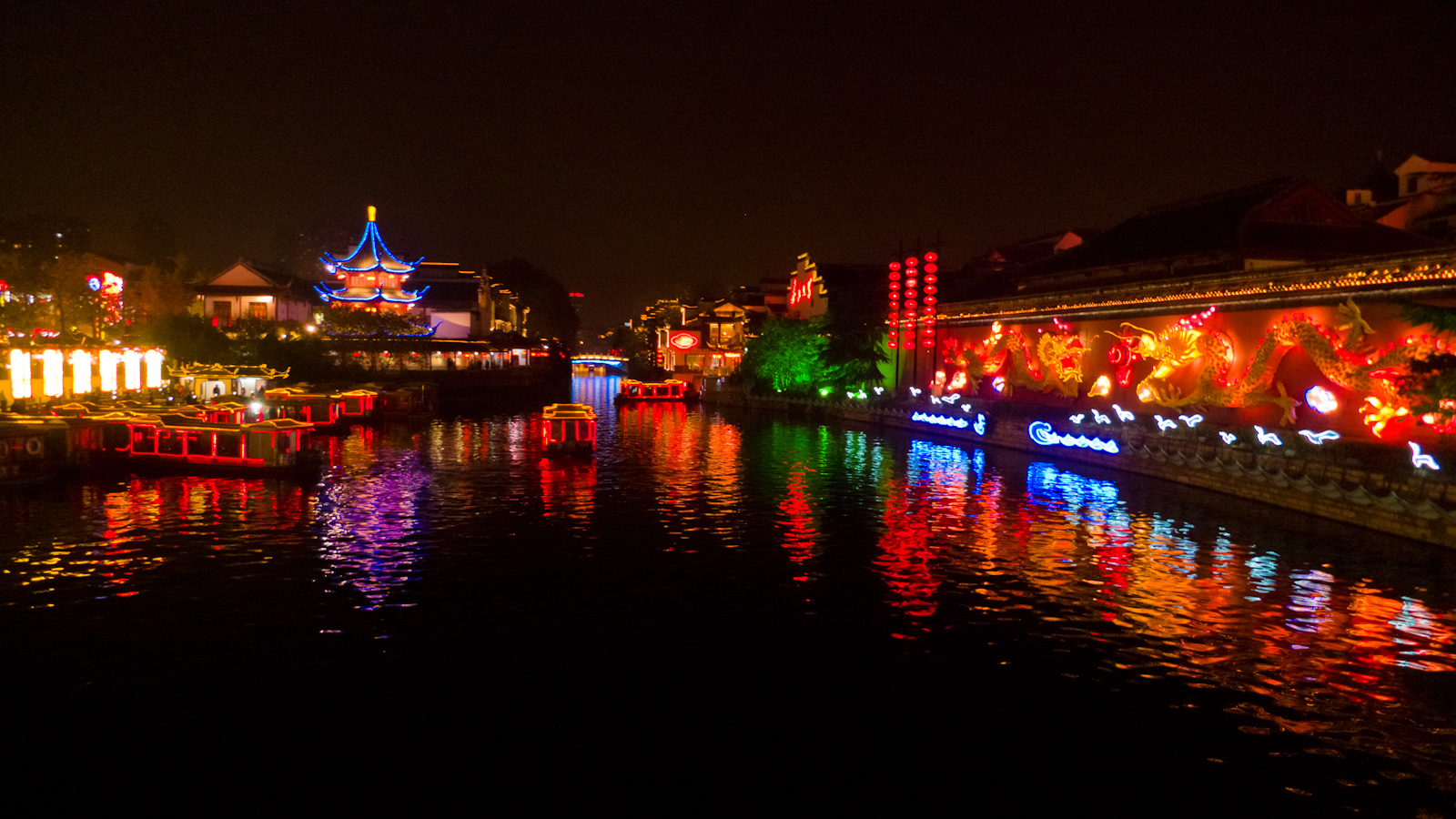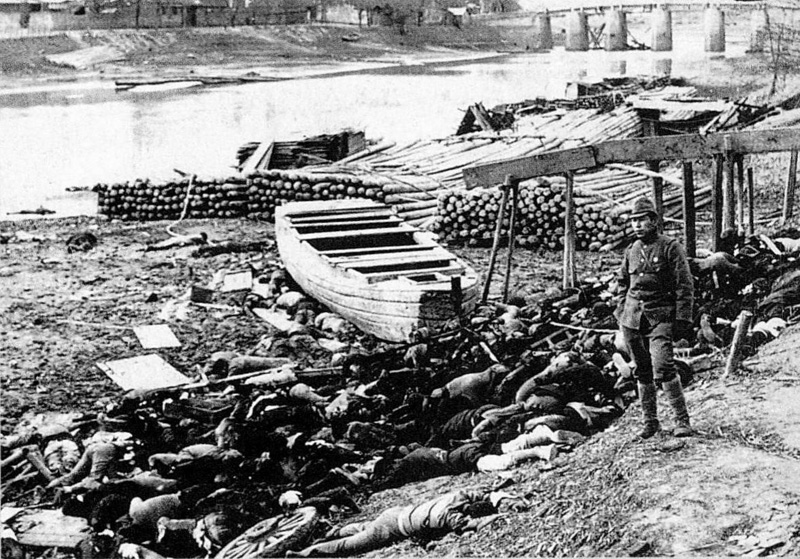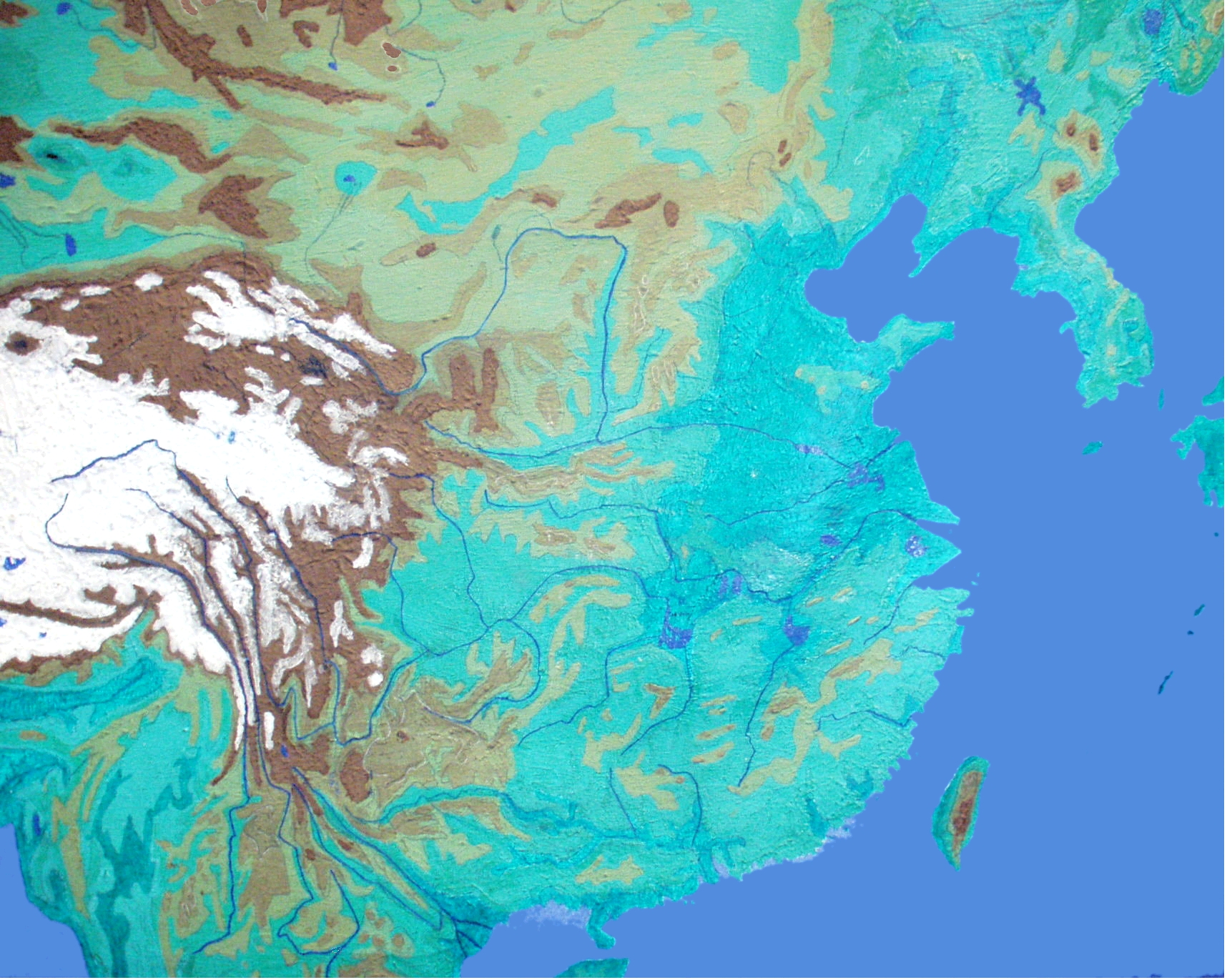|
Qinhuai River
The Qinhuai River () is a tributary of the Yangtze with a total length of 110 km. It flows through central Nanjing and is called "Nanjing's mother river". It is the "life blood" of the city. The Qinhuai River is divided into inner and outer rivers. The scenic belt along the Qinhuai River meets with the Confucius Temple at the center and the river serving as a bond. The belt, featuring attractions such as Zhanyuan Garden, the Confucius Temple, Egret Islet, China Gate as well as the sailing boats in the river and pavilions and towers on the riverbanks, is a blend of historic sites, gardens, barges, streets, pavilions, towers, folk culture and customs. History The Qinhuai River used to be called Huai Water and was renamed Qinhuai to the legend that Qin Emperor Shihuang, the first emperor of the Qin dynasty (221–206 BC), ordered to introduce Huai Water to the city by excavating a mountain. It is a branch of the Yangtze River, running about 110 kilometres, a major watercourse ... [...More Info...] [...Related Items...] OR: [Wikipedia] [Google] [Baidu] |
People's Republic Of China
China, officially the People's Republic of China (PRC), is a country in East Asia. It is the world's List of countries and dependencies by population, most populous country, with a Population of China, population exceeding 1.4 billion, slightly ahead of India. China spans the equivalent of five time zones and Borders of China, borders fourteen countries by land, the List of countries and territories by land borders, most of any country in the world, tied with Russia. Covering an area of approximately , it is the world's third List of countries and dependencies by area, largest country by total land area. The country consists of 22 provinces of China, provinces, five autonomous regions of China, autonomous regions, four direct-administered municipalities of China, municipalities, and two special administrative regions of China, Special Administrative Regions (Hong Kong and Macau). The national capital is Beijing, and the List of cities in China by population, most populous ci ... [...More Info...] [...Related Items...] OR: [Wikipedia] [Google] [Baidu] |
Courtesans
Courtesan, in modern usage, is a euphemism for a "kept" mistress or prostitute, particularly one with wealthy, powerful, or influential clients. The term historically referred to a courtier, a person who attended the court of a monarch or other powerful person. History In European feudal society, the court was the centre of government as well as the residence of the monarch, and social and political life were often completely mixed together. Prior to the Renaissance, courtesans served to convey information to visiting dignitaries, when servants could not be trusted. In Renaissance Europe, courtiers played an extremely important role in upper-class society. As it was customary during this time for royal couples to lead separate lives—commonly marrying simply to preserve bloodlines and to secure political alliances—men and women would often seek gratification and companionship from people living at court. In fact, the verb 'to court' originally meant "to be or reside at cou ... [...More Info...] [...Related Items...] OR: [Wikipedia] [Google] [Baidu] |
Nanjing Massacre
The Nanjing Massacre (, ja, 南京大虐殺, Nankin Daigyakusatsu) or the Rape of Nanjing (formerly romanized as ''Nanking'') was the mass murder of Chinese civilians in Nanjing, the capital of the Republic of China, immediately after the Battle of Nanking in the Second Sino-Japanese War, by the Imperial Japanese Army. Beginning on December 13, 1937, the massacre lasted six weeks. The perpetrators also committed other war crimes such as mass rape, looting, and arson. The massacre was one of the worst atrocities committed during World War II. The Japanese Army had pushed quickly through China after capturing Shanghai in November 1937. By early December, it was on the outskirts of Nanjing. The speed of the army's advance was likely due to commanders allowing looting and rape along the way. As the Japanese approached, the Chinese army withdrew the bulk of its forces since Nanjing was not a defensible position. The civilian government of Nanjing fled, leaving the city under th ... [...More Info...] [...Related Items...] OR: [Wikipedia] [Google] [Baidu] |
Chen Yuanyuan
Chen Yuanyuan (1624–1681) was a Chinese courtesan who lived during the late Ming and early Qing dynasties. She was the concubine of Wu Sangui, the Ming dynasty general who surrendered Shanhai Pass to the Manchu-led Qing dynasty, and later rebelled in the Revolt of the Three Feudatories. Chen's life and relationship to Wu later became the subject of a number of popular stories and legends, many of them focusing on her supposed role in Wu's fateful decision to defect to the Qing, thereby sealing the fate of the Ming dynasty. In one story popularized during the Kangxi era, when the peasant Li Zicheng rebelled against the Ming dynasty, he captured Chen Yuanyuan. This enraged Wu Sangui and made him side with the Qing dynasty to crush Li Zicheng's forces. Biography Chen Yuanyuan was born to a peasant family in Jiangsu province, and on the death of her father, she became a courtesan. Chen became a leading figure in the Suzhou '' kunqu'' scene. An account praised her performance as t ... [...More Info...] [...Related Items...] OR: [Wikipedia] [Google] [Baidu] |
Liu Rushi
Liu Rushi (; 1618–1664), also known as Yang Ai (杨爱), Liu Shi (柳是), Liu Yin (柳隐) and Yang Yin (杨隐),Yang Yinlian (杨影怜), Hedong Jun (河东君), was a Chinese '' yiji'' (courtesan), poet, calligrapher, and painter in the late Ming dynasty and early Qing dynasty. Early in her life, she had a relationship with Chen Zilong with whom she exchanged verses. She married the scholar-official Qian Qianyi, who was 36 years her senior, at the age of 25. She committed suicide shortly after he died. She is one of the " Eight Beauties of Qinhuai" described by late Qing official Zhang Jingqi.* In addition to her creative works (many of which have survived) and independent spirit (she often cross-dressed), she has been revered in later times for her unwavering love for her husband and for her country (the Ming) during the Ming–Qing transition. Historian Chen Yinke, who spent decades researching and writing about her, characterizes Liu Rushi as "a heroine, a belle, a word ... [...More Info...] [...Related Items...] OR: [Wikipedia] [Google] [Baidu] |
Ma Xianglan
Ma Shouzhen (; c. 1548–1604), also known by her courtesy name Ma Xianglan (, meaning "Orchid of the Xiang River") and pen name Yuejiao ("Lunar Beauty"), was a Chinese courtesan and artist born in Nanjing during the late Ming dynasty (1550–1644). She was a renowned painter, poet, and composer. She received the name Xianglan because her most favored paintings were of orchids. Biography Ma was born in Nanjing, and she lived in the entertainment district along the Qinhuai River. As a matriarch in courtesan society, she encouraged the education and training of courtesans in the arts. In order to maintain her reputation as an elite courtesan, she only allowed educated men or young student lords within her residence. During the late Ming dynasty, elite courtesans challenged the gender stereotypes of Confucian values. In contrast to the women of the gentry, who were often discouraged from cultivating talent lest it undermine their virtue as wives and mothers, courtesans wer ... [...More Info...] [...Related Items...] OR: [Wikipedia] [Google] [Baidu] |
Li Xiangjun
Li Xiangjun (; 1624–1654) was a courtesan, singer, and musician during the Ming dynasty. Her life was dramatised in the play '' The Peach Blossom Fan''. Biography Li is referred to as Li Ji () or Li Xiang () in contemporary sources. To demonstrate respect for her, later scholars appended the character ''jun'' () to her name. Her courtesy name was Shanzhui (). No written records from the time Li lived record where she was born, but popular modern theories suggest that she was the daughter of an official, who was demoted and his family either killed or sold. Li was adopted by the owner of a brothel in Nanjing called Meixiang House (), whose surname she took. She was taught to dance, sing, paint, play music, and write poetry. Meixiang House was a favoured brothel of the literati and officials, with Li's adopted mother known for her generosity and chivalry. By age 13, Li was renowned for her singing and playing the pipa that her mistress charged 20 gold taels per guest to see ... [...More Info...] [...Related Items...] OR: [Wikipedia] [Google] [Baidu] |
Dong Xiaowan
Dong Xiaowan (1624–1651), also known as Dong Bai, was a Chinese courtesan, poet and writer, also known by her pen name Qinglian. Dong has been described as the most famous courtesan of her time, known for her beauty and talent in singing, acting, needlework and the tea ceremony. She lived in the brothel district of Nanjing. Similar to other courtesans of the late Ming Dynasty, Dong's moral qualities were emphasised among her admirers more than her talents. She is one of the ''Eight Beauties of Qinhuai'' () described by late Qing officials. The other famed courtesans of this group are Ma Xianglan, Bian Yujing (), Li Xiangjun, Liu Rushi, Gu Mei, Kou Baimen (), and Chen Yuanyuan. Marriage Dong's mother died in 1642, leaving her to struggle financially. The noble Mao Bijiang (), alternatively known as Mao Xiang, had attempted to meet with Dong several times, but had pursued a relationship with the courtesan Chen Yuanyuan instead. After Chen was abducted by a noble associated ... [...More Info...] [...Related Items...] OR: [Wikipedia] [Google] [Baidu] |
Gu Mei
Gu Mei (; 1619–1664), better known by her art name Gu Hengbo (), also known as Xu Mei and Xu Zhizhu after her marriage, was a Chinese courtesan, poet and painter. She received the title "Lady (furen)" from the early Qing court, and often addressed as "Lady Hengbo" in Qing writings. Gu was famous for her beauty and talent within painting and poetry and counted among the elite of courtesans alongside Dong Xiaowan, Bian Yujing and Liu Rushi. She was admired for her paintings of orchids, and published a collection of poems which was given good critics, although few of her works have survived. Life Gu Mei was born near Nanjing in 1619. At the beginning of the Chongzhen reign, Gu Mei became a courtesan in the Qinhuai River district of Nanjing. In her Tower Meilou in Qinhuai district in Nanjing, she hosted a famous literary salon, which counted Chen Liang, Qian Lucan and Mao Xiang among its guests. Yu Huai described Meilou (literally ''house of bewitchment'') as lavish and extr ... [...More Info...] [...Related Items...] OR: [Wikipedia] [Google] [Baidu] |
Ming
The Ming dynasty (), officially the Great Ming, was an imperial dynasty of China, ruling from 1368 to 1644 following the collapse of the Mongol-led Yuan dynasty. The Ming dynasty was the last orthodox dynasty of China ruled by the Han people, the majority ethnic group in China. Although the primary capital of Beijing fell in 1644 to a rebellion led by Li Zicheng (who established the short-lived Shun dynasty), numerous rump regimes ruled by remnants of the Ming imperial family—collectively called the Southern Ming—survived until 1662. The Ming dynasty's founder, the Hongwu Emperor (r. 1368–1398), attempted to create a society of self-sufficient rural communities ordered in a rigid, immobile system that would guarantee and support a permanent class of soldiers for his dynasty: the empire's standing army exceeded one million troops and the navy's dockyards in Nanjing were the largest in the world. He also took great care breaking the power of the court eunuchs and unr ... [...More Info...] [...Related Items...] OR: [Wikipedia] [Google] [Baidu] |
Nanjing
Nanjing (; , Mandarin pronunciation: ), Postal Map Romanization, alternately romanized as Nanking, is the capital of Jiangsu Provinces of China, province of the China, People's Republic of China. It is a sub-provincial city, a megacity, and the List of cities in China by population, second largest city in the East China region. The city has 11 districts, an administrative area of , and a total recorded population of 9,314,685 . Situated in the Yangtze River Delta region, Nanjing has a prominent place in Chinese history and Chinese culture, culture, having served as the historical capitals of China, capital of various Dynasties in Chinese history, Chinese dynasties, kingdoms and republican governments dating from the 3rd century to 1949, and has thus long been a major center of culture, education, research, politics, economy, transport networks and tourism, being the home to Port of Nanjing, one of the world's largest inland ports. The city is also one of the fifteen sub-provin ... [...More Info...] [...Related Items...] OR: [Wikipedia] [Google] [Baidu] |
Yangtze River
The Yangtze or Yangzi ( or ; ) is the longest river in Asia, the third-longest in the world, and the longest in the world to flow entirely within one country. It rises at Jari Hill in the Tanggula Mountains (Tibetan Plateau) and flows in a generally easterly direction to the East China Sea. It is the seventh-largest river by discharge volume in the world. Its drainage basin comprises one-fifth of the land area of China, and is home to nearly one-third of the country's population. The Yangtze has played a major role in the history, culture, and economy of China. For thousands of years, the river has been used for water, irrigation, sanitation, transportation, industry, boundary-marking, and war. The prosperous Yangtze Delta generates as much as 20% of China's GDP. The Three Gorges Dam on the Yangtze is the largest hydro-electric power station in the world that is in use. In mid-2014, the Chinese government announced it was building a multi-tier transport netw ... [...More Info...] [...Related Items...] OR: [Wikipedia] [Google] [Baidu] |






